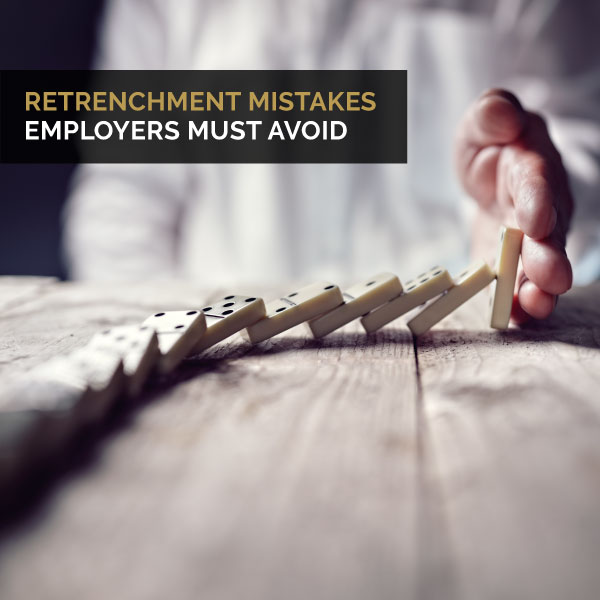RETRENCHMENT MISTAKES EMPLOYERS MUST AVOID
When their market shrinks, especially in a struggling economy, companies must find ways to reduce their operational costs, and retrenchment may become an unavoidable option. It’s an unfortunate but sometimes necessary decision that can traumatise both dismissed employees and remaining staff, leaving psychological scars long afterwards.
To protect them from undue distress, the entire process is regulated by specific legal requirements, stipulated in Section 189 of the Labour Relations Act 66 of 1995. Yet many employers fail to satisfy these conditions and find themselves on the losing side of a judgment in Labour Court. To make sure they don’t, they should avoid the following common mistakes.
Being ignorant of the law
None of the legal requirements for retrenchments can be skipped or reduced, and the onus is on the employer to prove that all the provisions of the Act have been satisfied. It is therefore recommended to seek legal counsel to guide or facilitate the retrenchments, rather than attempt to complete the process yourself.
Delaying notification
After it becomes apparent that retrenchments could be necessary, employers must, as soon as reasonably possible, serve notice on the affected employees. Section 189, subsection 3, of the Act also clearly describes what information must be included in the notice.
No employer is eager to retrench, so they may spend too much time seeking alternatives, hoping to turn the business around. However, the longer they delay, the more pressure they face to complete the process quicker, leading to the next complication.
Rushing the consultation process
Employers are required to consult with their employees, or their union or employee representatives. This is a serious process through which consensus must be sought on appropriate measures to avoid the dismissals, minimise them, change their timing, mitigate their adverse effects;the method of selecting the employees to be dismissed, and their severance pay.
The consultation cannot be rushed or short circuited in any way and the entire retrenchment can take quite long. For large scale retrenchments, at least 60 days are required. So employers should start consultation as soon as possible.
Not serving notification correctly
Another area of concern is the incorrect serving of notices. Apart from ensuring they contain the right information, employers must serve notices to all employees who may possibly be affected by the retrenchment, whether they will be dismissed or not, and not only those targeted for dismissal.
Not keeping the process impartial
Employers should never handpick or preconceive who will be dismissed before the consultation. Rather, the appropriate selection criteria must be determined by the employer and then consulted on with the potentially affected parties and should be applied in an unbiased manner, such as last-in-first-out, retention of skills, etc.
Not making the consultation inclusive
Employers who believe the consultation is just a platform to announce their intention to retrench are gravely mistaken. In the case of NUMSA vs Dorbyl, the Labour Court judge determined that the decision to retrench had been taken at an executive level before consultation began. This rendered the consultation meaningless and the retrenchment invalid. The company was ordered to pay wages to 122 workers over the time that had passed since the dismissal. Organisations must therefore recognise that the process is a two-way street.
Having the wrong attitude
As the case above illustrates, retrenchment should be seen as a last resort and not an inevitable outcome. Even then, every effort must be made to minimise its impact. Any indication otherwise could render the entire process void and force the organisation to start from scratch, wasting time, money and resources. This requires that employers enter the consultation with an attitude that is open to negotiation, collaborative and ready to embrace alternatives.
Not structuring retrenchment packages correctly
For those workers who are finally retrenched, the law makes provision for special tax rates that will help preserve the precious funds keeping them afloat until they find a new position. However, certain conditions apply. Unable to spare their jobs, an employer should make every effort to meet all the requirements to ensure these former staff members realise the maximum tax benefits possible. The assistance of a remuneration specialist is advised.
Not motivating remaining staff
So you’ve ensured your retrenchment policies are robust and compliant, and that your retrenchment packages are structured to offer the greatest value to exiting employees. But what about those staying behind, who feel overwhelmed by what just happened and what the future holds? Research shows that creating a sense of control can quickly restore normal performance. Apart from counseling, initiatives like flexible benefits can do the trick.
AUTHORS

Mariana Stander |

Grant Wilkinson |
![2025-logo-[Recovered] Tax Consulting South Africa](https://www.taxconsulting.co.za/wp-content/uploads/2025/01/2025-logo-Recovered.png)



